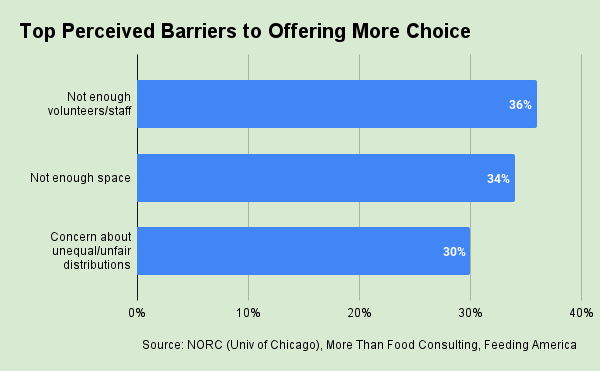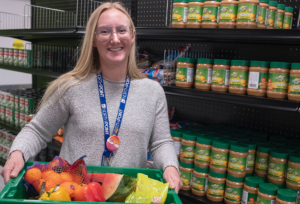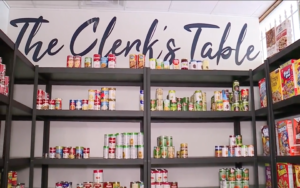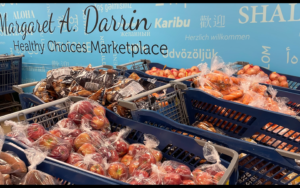Letting food pantry clients choose their own food is widely accepted as a dignified way to distribute charitable food. But for pantries that have always packed up bags, moving to that “client choice” model can be an intimidating prospect.
The dilemma is aptly summed up in a survey from December 2022, which showed that 56% of about 300 staff and volunteers at nearly 130 pantries thought it was “very important” to offer choice. But only 42% of them felt “very prepared” to do so. (NORC at the University of Chicago and More Than Food Consulting collaborated with Feeding America on the survey, which was funded by Morgan Stanley Foundation.)
Among the perceived obstacles:
- 36% worried about having enough staff or volunteers
- 34% thought they might not have enough space
- 30% were concerned that client choice would mean unequal or unfair distribution
Despite such challenges, the first-hand experiences of those that have made the move suggest client choice offers ample benefits for staff, volunteers and patrons. Of pantries that increased their level of choice over a year, 79% reported an improvement in overall operations, according to the NORC and More Than Food Consulting researchers. Pantries also reported reduced food waste, increased satisfaction among staff and volunteers and an increased sense of dignity among patrons.
“I can’t express enough the shift when a pantry goes from pre-bagging food to offering folks the ability and dignity to choose their own food,” said Katie Martin, PhD, CEO of More Than Food Consulting. “It just opens the door for so many other beautiful things to happen at a food pantry.”
Ratcliffe Elementary School Market in Richmond, Va., saw the benefits first-hand when it shifted to a “shopping style” model in 2022. The pantry, which started during the pandemic, initially operated a drive-through pantry, offering pre-bagged foods to families with students at the school.
However, when Covid restrictions began lifting, the pantry’s food bank partner asked the school if it would consider a client choice model, said Leslie McGuinn, Pantry Director. “We did the shift this year, and the families have absolutely loved it,” she said. “It’s been very beneficial.”
Since implementing the new model, McGuinn said that her team had noticed a significant reduction in food waste. More than that, she said that the work for volunteers didn’t increase with client choice. If anything, she said the work became less tedious because volunteers didn’t need to bag food and deliver them to cars.
The most significant benefit, however, has been the connection and community building that school staff and volunteers have been able to experience since switching to the new model. “Being able to build those relationships has been the best part of it,” said McGuinn.
Pantries aren’t the only ones that can adopt a client choice model — food banks can too. Feeding San Diego, a food bank and food rescue organization, used to keep prepackaged “emergency boxes” of food for anyone who happened to come to its main distribution center expecting a traditional pantry.
Responding to the need, Feeding San Diego opened its own client choice marketplace in 2022, offering community members a once-a-month opportunity to shop for free groceries — much of it rescued from local grocery stores. The food bank created the market by splitting its break room in half and installing a door to the outside.
The response from the community has been incredible, said Patty O’Connor, Chief Supply Chain Officer. “It’s almost unbelievable. People are so thrilled that they can come in and choose what they like to eat and what they want to serve to their family,” she said.

Moving to client choice need not be an all or nothing proposition, Martin noted. Limited versions of choice include allowing clients to choose between two types of pre-packaged bags, or letting them pick a few items to add to (or remove from) a pre-packaged bag. Choice also does not mean unlimited quantities. “You can offer full choice while setting limits on how much quantity of certain items people can take, just based on how much food is available for a food pantry,” Martin said.
Lift Up, a food pantry operating in downtown Portland, Ore., has been a client choice pantry since 2007 but underwent a process in 2019 to ease the number of limits on most food items. The pantry calls its approach the “justice model.”
Previous limits weren’t based on the amount of food available — they were based on what others said was an appropriate amount of food for each client, said Program Manager Teresa Steichen. “We used to have more limits. They didn’t make a lot of sense. We spent a year revamping how much food we let people take with them and let it be their choice.”
“A lot of the volunteers thought it wouldn’t work,” Steichen noted. “They were convinced that all of the peanut butter and tuna fish would be gone in like 10 minutes,” she said. “And it really didn’t happen.”
Limits are placed only on certain food items to ensure that all clients can have equitable access to the same amount of food, said Executive Director Stephanie Barr. “Teresa likes to say the food doesn’t belong to us — it belongs to the community,” Barr said. “It’s not our job to control. It’s our job to make the food available.” – Mike Peterson
Mike Peterson is a San Diego-based writer, editor, and strategist who is passionate about finding and telling stories that matter.
Like what you’re reading?
Support Food Bank News








